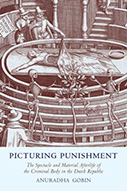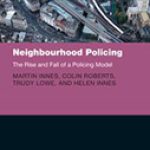Picturing Punishment: The Spectacle and Material Afterlife of the Criminal Body in the Dutch Republic

Author: Anuradha Gobin
Publisher: University of Toronto Press, 2021. 304 pages.
Reviewer: Sarah Tarlow ǀ June 2022
Afterlives are having a moment. The history of bodily punishment is still dominated by Foucauldian narratives emphasising the early modern shift in emphasis from inflicting pain to enforcing discipline, and from retribution to reform. However, there are parallel histories of the criminal body which place it in different stories. These include the role of the corpse in generating and reproducing modern scientific knowledge of anatomy and medicine, and its theatrical manipulation in carefully designed spectacles of social and political power. The interesting thing about these other narratives is that their primary audience is not suggested to be the criminal him- or herself, but society at large. The choreographer of these spectacles of punishment is one or many members of powerful hegemonies – of political authority, knowledge, cultural meaning or social control.
Picturing Punishment uses various sorts of evidence, but primarily art historical material, to examine the way that the criminal body was staged and framed during and after execution, and the impact of these carefully considered settings. Anuradha Gobin undertakes an often minute study of architectural detail, including the choices of paintings and murals decorating the places of justice in early modern Netherlands (the title refers to the United Provinces of the Dutch Republic, but the emphasis here is very much on the major cities at the heart of Dutch power; it would be interesting to know how the practices and attitudes outlined here compare to those in small settlements, rural areas and the administration of justice in the colonial contexts of, say, South Africa or Batavia). She notes that what appeared to be a wholly open and transparent process of trial, judgement and sentencing was in fact a managed performance of objectivity and disinterest, making use of deliberate architectural design features of the new town hall of Amsterdam, completed in the 1650s, when the real decisions had already happened out of sight. The narrative of transparency was scaffolded with paintings and other artistic references to classical or biblical stories with a theme of impartial justice. The audience for this elaborate performative judgement was mostly the townspeople of Amsterdam, whose participation in public life was essential to maintaining the presentation of an orderly and fair society. It is rare to see such detailed consideration of the symbolic workings of the physical spaces of law, and an engaging feature of this book. Following her extended case study of Amsterdam town hall and the spectacle of condemnation and execution within and adjacent to the building, we follow the criminal body, now dead, to the special gallows fields, common in early modern Dutch towns and cities, as through much of the rest of Europe. Typically situated in marginal areas outside the zones of urban development, gallows fields displayed executed remains in locations that would be conspicuous for travellers entering or leaving the city, as well as being popular spots for townspeople to make excursions for moral reflection or for less honourable pursuits. Amusingly, the Dutch word vogelen, meaning to hunt birds, which was an activity often depicted or alluded to at these places, was a slang term for sex, and trips to the gallows field often had bawdy overtones.
Gobin’s sources for the display of bodies in gibbet cages, or on forked stakes or wheels at gallows fields are primarily maps, landscapes, city views and sketches. Here, as in some other places, I would have liked to know more about the consumers of these artistic productions. Who saw, who commissioned, who used these kinds of depictions? Where this is relatively easy to understand in the case of architecture and prominently displayed paintings, sketches and maps might have had a much more limited or even entirely personal intended readership. This is an important part of the context of artistic production, and affects our interpretation. A further degree of historical contextualisation would have strengthened this aspect of the book.
For those bodies that did not end up slowly decomposing in a gallows field, their journeys took them to the anatomist’s table. Early Dutch anatomy schools are quite well researched and documented already, in part because of the significance of anatomists such as Vesalius and his successors including Pieter Paaw and Nicolaes Tulp, famously portrayed by Rembrandt. Gobin, however, takes us beyond the purpose-built and new anatomy schools to the other structures used for anatomical dissection, especially churches. This is not only for the practical reasons of providing spaces with good lighting, space and seating for observers and the cool temperatures required to retard decomposition, but also have the symbolic resonance of sacrifice and sacrament. This gets to the heart of the book’s themes – the tension between attempts by hegemonic authorities to control the knowledge and limit the meaning of the criminal body, and the tendency of meanings to proliferate and escape the bounds of authoritative readings. While an element of sacred sacrifice can add theological richness to the spectacle of punishment, too close an analogy between the executed criminal and the crucified Christ could weaken the moral message of public punishment. Penal theatre was supposed to have a deterrent effect, not to romanticise or immortalise a malefactor who was considered to have no place in an ordered and virtuous society. The theme of boundaries and how they are policed is relevant to many chapters: the boundaries of civil society are maintained by the theatre of justice that controls its membership; the boundary of the city is emphasised by the use of liminal spaces such as gallows fields for the symbolic elaboration of the borderlands of civilisation. Later, the skin of the body forms another important frontier, though this function is not extensively discussed or brought into symmetry with the social and geographical borders discussed earlier.
Cultural historians have discussed anatomical dissection at length, and Gobin references a number of these. Interestingly, however, she takes the body beyond the event of a dissection with all that it implies about knowledge, authority and the development of modern science, into the ultimate destinations of the human remains themselves. Even the fragmentation of the dead body was not the end: skeletal remains became part of museum collections or ornamented social spaces of control. Gobin pays particular attention to the sense of touch – the actual sensory bodily encounter with the criminal corpse, and with the organ of touch – the skin. She draws attention to the invocation of classical stories about skin and flaying, such as the story of how the satyr Marsyas was flayed by Apollo, or the horrific story of the corrupt judge Sisamnes, condemned by the Persian King Cambyses to be flayed and his skin used to cover the judge’s seat on which Sisamnes’ son was subsequently required to sit. The paintings and engravings of these events that are reproduced in this volume are still shocking. Even more grotesque are the representations of the flayed skin of criminals being examined and handled by curious medical students like a macabre onesie. One of these pictures was so grim I had to find a way of holding the book so that I could read the adjacent page without upsetting myself.
Picturing Punishment is an attractively produced and well-illustrated volume. It is always enjoyable to read a book with pictures, despite the harrowing flayed skins. I would have liked to see more information in the captions, rather than just the title and source. It is helpful to have one’s attention drawn to the key notable features of an illustration, even when it is discussed elsewhere. The material presented is solid and well-referenced. There are still vestiges of the doctoral dissertation about the text: some clunky sentences of the form, ‘This shows that…’, or ‘This symbolises…’, and overall, the discussion of symbolism reads in places like the decryption of a code rather than a subtle evocation of multiple meanings. Similarly, the structure of the PhD survives in the chapters’ final paragraphs which tend to be a summary of the chapter, and in the conclusion, which is very brief and repeats the main points made elsewhere, rather than integrating them further into a new argument. This book is, however, innovative, in bringing together a range of sources and subjects of study. It is rare to see buildings, spaces and geography given such careful attention in crime history, and it is also unusual to take the whole journey of criminal body from trial to ultimate disposal or curation of a body in pieces. While it is clear that the subjects discussed are related, the exact nature of the relationship is not always fully explored. So, for example, it seems evident that the sense of touch in the explorations of the anatomist is important, and it seems to be connected with skin in some way– but the actual significance of the flayed skin of the criminal is not made explicit.
This is a good book, and represents a deep engagement with the scholarship of a number of disciplines and in different geographical contexts, but I would have liked to have ridden the wave of Gobin’s knowledge even further, and be taken to a set of larger and more ambitious conclusions.
Professor Sarah Tarlow, School of Archaeology and Ancient History, University of Leicester


